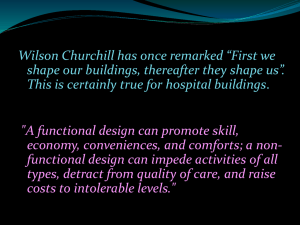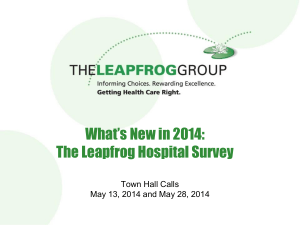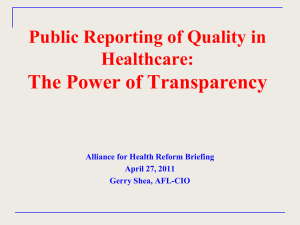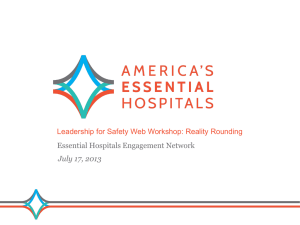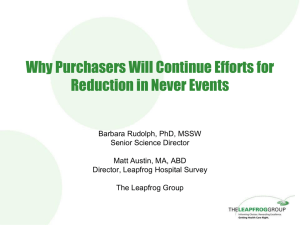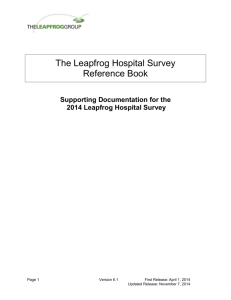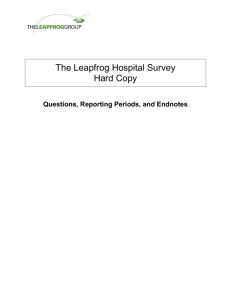here - The Leapfrog Group
advertisement
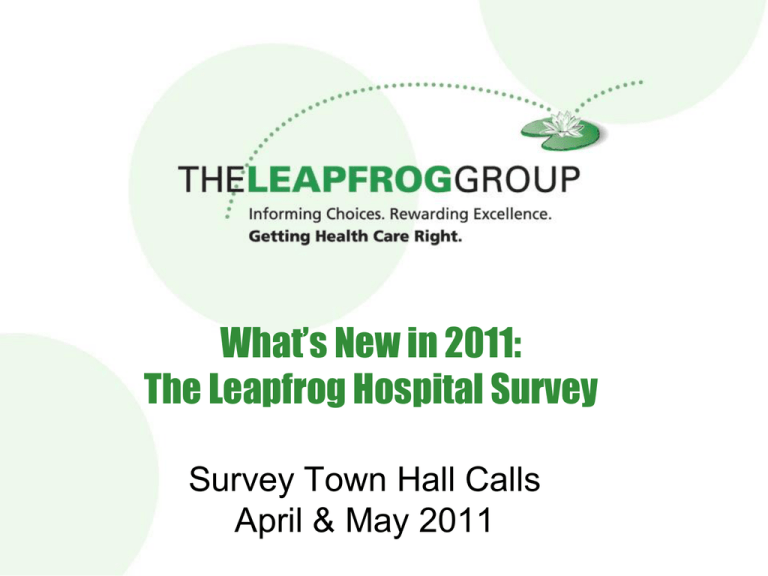
What’s New in 2011: The Leapfrog Hospital Survey Survey Town Hall Calls April & May 2011 11 Town Hall Call Overview • • • • • Introduction – Survey Team – Leapfrog and the Leapfrog Hospital Survey—why complete? – Goals for 2011 survey Survey Submission Logistics/Timeline/Website Resources What’s New for 2011 – Computerized Physician Order Entry (CPOE) – Evidence-based Hospital Referral (EBHR) – Common Acute Conditions (CACs) • Normal Deliveries – ICU Physician Staffing (IPS) – National Quality Forum (NQF) Safe Practices • Magnet-designated hospitals – Hospital Acquired Conditions (HACs) • Central line associated blood stream infections (CLABSI) • Hospital-acquired pressure ulcers & injuries – Two new survey sections: • Smooth Patient Scheduling (Section 8) • Patient Experience of Care (Section 9) Q&A Schedule for Town Hall Calls 2 Why Complete Leapfrog Survey? Unique in the Milieu • • • • • • • • • • Measures represent employers/purchasers/consumers interests Requires public accountability/transparency Rewards high performance Contains meaningful measures with high impact “not the low hanging fruit measures” (e.g., CPOE, IPS, EBHR, HACs, Deliveries) Full range of measures—structural, process and outcome (but focused on outcome—36 measures) Regional and national in scope—all payer/all patient information Standardized measures to assure “same fruit” is sampled Harmonized with other major national performance measurement programs—but shows more complete picture of care delivery Significant hospital input on survey revisions CPOE Evaluation Tool is a one-of-a-kind opportunity to check meaningful use 3 Survey Review Process Steps in the process to revise the survey have included: • (November, 2010) - Public review and comment period – hospitals and other stakeholders were invited to share comments and feedback on the proposed changes for the 2011 Leapfrog Hospital Survey. • (January, 2011) - Pilot test of revised survey – 25 hospitals were asked to test a draft of the 2011 Leapfrog Hospital Survey and provide feedback to Leapfrog. • Examples of feedback: (i) Two questions in Safe Practice #9 (Nursing Workforce) were duplicative; revised questions to remove duplication. (ii) Original section 8 scoring did not account for hospitals that have already achieved high utilization of current O.R. capacities; updated scoring to give credit to hospitals that have achieved 85%+ utilization. 4 Behind the Changes Goals for the survey— 1. Expand coverage to more hospitals 2. Keep burden as low as possible 3. Continue alignment with other performance measurement groups (such as CDC-NHSN; CMS; The Joint Commission) 4. Include cutting-edge measures that improve the quality and efficiency of care delivery 5. Maintain consistent measurement structure for LHRP and for improvement purposes 6. Update measures with guideline changes 7. Add new performance measurement entities 8. Maintain measures meaningful to purchasers and consumers 5 How did we do? • Bulk of survey remains identical to the 2010 survey • Added two new sections, to a) measure the hospital’s efficient use of existing capacities; and b) measure the patient’s experience of care • 2010 survey was 65 pages of questions — added 4 pages of questions for the two new survey sections • Updated measure specifications to maintain alignment with other measurement entities (CMS, The Joint Commission) • Shifted preference to national performance measurement systems where possible (STS, ACC) • Replaced existing measures with more meaningful measures (new version of CPOE Evaluation Tool, replace PCI process measures) • “Raised bar” for some performance targets 6 Survey Submission Logistics, Timeline, Website Resources 7 Survey Security and Integrity • Core principle: hospital self-certification • Executive authority and accountability • Survey security and integrity are critical: – 16-digit security code • Authorization to access granted only to: – CEO . . . can provide code directly to any delegate(s) – CEO-authorized delegate . . . Help Desk can email security codes. See survey home page link, “Get a Security Code” 8 Survey Helpdesk Available • Survey Helpdesk -- designed to respond within 1-2 business days (unless it requires an expert panel member to respond) • Link on survey homepage https://www.leapfroghospitalsurvey.org/helpdesk • Other tips: – Survey must be completed before CPOE Evaluation Tool is taken. Help Desk cannot respond in real time. Plan to complete early. – Don’t wait until late June. If you have a problem, you likely will not make deadline. 9 2011 Timeline • April 1, 2011 – Launched 2011 Survey • June 30, 2011 -- RRO-targeted hospitals report or be listed on Leapfrog’s website as “Declined To respond” • July 24, 2011 -- Leapfrog website lists new results • Top Hospitals List – 2011 recognition programs/ initiatives begin as early as mid-September 10 Website Resources See online survey home page for links to: • Leapfrog Hospital Survey Reference Book – Measure specifications (volume, process, resource utilization) – Frequently Asked Questions – Scoring Algorithms • Hardcopy survey including explanatory “end notes” • Other links on home page – – – – – – – – “What’s New in 2011” Survey deadlines Updates: Notable changes to survey or specs since 4/1/11 release Excel tool for computing Geometric Mean Length of Stay Supplemental info re: Resource Utilization scoring and Survival Predictors Ordering info for NQF’s Safe Practices for Better Healthcare: 2010 Update Fact sheets on each Leap (including bibliography information) White Papers on Severity-adjustment for LOS, and Survival Predictor 11 Leapfrog Hospital Survey Reference Book – Medical Coding for High-Risk Procedures and Conditions (EBHR) Procedure codes, diagnosis codes and other specifications for counting high-risk surgery volumes – EBHR Publicly Reported Outcomes for CABG and PCI For hospitals in CA, MA, NJ, NY and PA – publicly reported risk-adjusted mortality rates for responding to survey questions about PCI (MA, NY only) and CABG (all five states). – EBHR Process Measures -- Specifications Detailed specifications for Leapfrog’s procedure-specific process measures of quality for CABG, PCI, AAA Repair, and high-risk deliveries. – EBHR Resource Utilization Measures – Specifications Detailed specifications for Leapfrog’s CABG and PCI including: • Coding for counting eligible cases • Coding and other criteria for identifying cases with risk factors • Specifications for reporting geometric mean length of stay • Criteria for identifying cases followed by readmission 12 Leapfrog Hospital Survey Reference Book – Volume Standard Coding: Medical Coding for Chronic Acute Conditions (CAC) Procedure/diagnosis codes and other specifications for counting AMI and Pneumonia volume – CAC Process Measures – Specifications Specifications for Leapfrog’s nationally-endorsed condition-specific process measures of quality -- for AMI, Pneumonia, and Normal Deliveries. – CAC Resource Utilization Measures – Specifications Detailed specifications for Leapfrog’s Common Acute Conditions (AMI and Pneumonia) including: • Coding for counting eligible cases • Coding and other criteria for identifying cases with risk factors • Specifications for reporting geometric mean length of stay • Criteria for identifying cases followed by readmission – CAC Normal Deliveries Measures – Specifications • Early Delivery outcome measure • Process measures: Bilirubin screening, DVT prophylaxis for C-sections – Hospital-Acquired Conditions (HAC) – Specifications – Smooth Patient Scheduling Utilization Calculations 13 What’s New for 2011 14 Computerized Prescriber Order Entry (CPOE) Leap Change: Introduction of version 2.0 of the CPOE Evaluation Tool Includes both new simulated patients and problem orders Incorporates many comments hospitals have provided to Leapfrog and Tool developers over the last two years • • • • • • All medications are now listed in their generic form Added checkboxes on the observation sheet to accommodate structured orders [order sets/order sentences] Added new checkbox on the orders/observation sheet for dosing calculators The updated instructions provide guidance on what to do with 'per protocol' ordering for high-risk medications The drug-drug alerts being tested are now those that are categorized as most severe, as agreed upon by most major vendors Removed three order checking categories: Drug-food interactions, Cost of Care, and Contraindication based on radiology studies 15 Computerized Prescriber Order Entry (CPOE) Leap Reasoning: First version of the Tool was developed early in previous decade; hospitals have advanced in their use of decision support tools Impact: Leapfrog’s CPOE standard will remain the same in 2011 To fully meet the standard: (1) At least 75% of inpatient medication orders are entered through hospital’s CPOE system AND (2) Hospitals demonstrate effective implementation of their CPOE system by achieving a score of “Fully Meets Standards” or “Good Progress” on the CPOE Evaluation Tool (requires score of >=50% on drug:drug and drug:allergy order checking categories + score of >=50% on two additional order checking categories) 16 ICU Physician Staffing (IPS) Leap Change: Remove the opportunity for hospitals to indicate a commitment date for fully meeting Leapfrog’s standard for IPS Reasoning: After 10 years of asking hospitals to implement the IPS Leap and publicly reporting those results, reporting future commitments is no longer appropriate. 17 ICU Physician Staffing (IPS) Leap Impact: Scoring algorithms for Substantial Progress (3 bars) and Some Progress (2 bars) have been updated to reflect the removal of the commitment; Requirements for fully meeting the standard have not changed. To fully meet the standard: • Intensivists and neurointensivists manage or co-manage patients in all adult and pediatric medical and/or surgical ICUs and neuro ICUs; and • Intensivists are ordinarily present in the ICU* during daytime hours (min. of 8 hours a day, 7 days a week) and provide care exclusively in the ICU; and • Intensivists respond to urgent pages within 5 minutes, >=95% of time; and • On-site physician, PA, NP, or FCCS-certified nurse “effector” can reach ICU patients with 5 minutes, >=95% of time. *24 hr x 7 day/week tele-monitoring w/ care planning done by on-site intensivist can be substituted for 8 x 7 on-site presence 18 Evidence Based Hospital Referral (EBHR) Leap Change #1: Leapfrog has shifted its preference for cardiac surgery outcome reporting from state reports to national performance measurement systems. Reasoning: As Leapfrog is a national organization and its purchaser members often have covered lives in many states, when and where possible, we want to give a preference to measures that are comparable nationally 19 Evidence Based Hospital Referral (EBHR) Leap Impact: • For CABG, PCI, AVR: – Hospitals that participate in STS or ACC NCDR CathPCI will be asked to report their risk-adjusted mortality from latest report – If hospital doesn’t participate, they can report data from an approved state report (CA, MA, NJ, NY, PA) or regional registry (Northern New England; BCBS of Michigan) – Scoring algorithms have been tweaked to reflect this change in preference – For hospitals that don’t report a risk-adjusted outcome, will continue to calculate a Survival Predictor • AAA, Esophagectomy, Pancreatectomy – Survival Predictor remains primary quality metric 20 Evidence Based Hospital Referral (EBHR) Leap Change #2: Replaced the three current PCI process measures (% patients with door-to-balloon within 90 minutes; aspirin at arrival; aspirin at discharge) with median door-to-balloon time; median time needs to be <=60 minutes to earn credit Reasoning: The research shows that there is an almost linear relationship between door-to-balloon time and mortality for AMI patients Note: 25% of hospitals that participate in NCDR CathPCI registry have median time of 62 minutes or less. 21 Evidence Based Hospital Referral (EBHR) Leap Impact: Hospitals that report median time at/under 60 minutes will be given 1 bar ‘extra credit’; in previous surveys, hospitals had to be at 80%+ adherence for 2 of the 3 process measures to earn ‘extra credit’ 22 Common Acute Conditions (CACs) Change: For ‘Elective Deliveries Before 39 Weeks’ measure, performance target updated from 12% to 5% Reasoning: • Over 25% of hospitals that reported to 2010 survey reported a rate <=5% • Aligns with The Joint Commission thinking on an appropriate target • Zero is not a realistic goal for measure in current form, as measure exclusions don’t capture every reason a delivery would be appropriate before 39 completed weeks 23 Elective Deliveries Before 39 Wks Distribution of Elective Delivery Rates Before 39 Completed Weeks Reported to the Leapfrog Hospital Survey (Data as of 03/28/2011) Number of Hospitals 250 30% 23% 200 150 13% 13% 100 10% 4% 50 6% 0 0-5% 5-12% 12-20% 20-28% 28-36% 36-44% Elective Delivery Rate Before 39 Completed Weeks 24 44+ Common Acute Conditions (CACs) Impact: For hospitals to receive credit on ‘Elective Deliveries Before 39 Weeks’ measure, need to be at or under 5%. Important Notes: – Hospitals can report the data they submit to The Joint Commission for this measure (Perinatal Care measure #1) – Leapfrog has updated survey measure specifications to maintain alignment with TJC. 25 NQF Safe Practices Change/Impact: Streamlined the survey response pattern for Safe Practice #9 (Nursing Workforce), so that hospitals that carry ANCC Magnet status can receive full credit for the Safe Practice simply by indicating their status at the beginning of the practice Reasoning: The Safe Practice FAQs have indicated that a hospital that carries the Magnet designation meets all of the requirements for the Safe Practice, but hospitals still had to check every box to reflect full credit; streamlining response burden. 26 Hospital-Acquired Conditions (HACs) Change: Added two ICUs for central line associated bloodstream infection (CLABSI) reporting – Neurosurgical ICU – Surgical Cardiothoracic ICU Reasoning: Extend reporting coverage to ICUs that provide postsurgical care to high-risk patients Impact: Hospital’s CLABSI rates will be incorporated into the standardized infection ratio (SIR) 27 Hospital-Acquired Conditions (HACs) Change: Hospitals can earn 1 bar ‘extra credit’ if they utilize personnel trained in human factors engineering in conducting root-cause analyses of adverse events Reasoning: Personnel trained in human factors engineering are trained to study the interaction between the human and the system, including the work environment, tools, and computer systems; root-cause analyses conducted by such persons bring a valuable perspective Impact: Hospitals that are in lowest (worst) performance category for CLABSI based on SIR are eligible for extra credit; opportunity is an alternative to extra credit for participation in ON THE CUSP: STOP BSI 28 Section 8 : Smooth Patient Scheduling (NEW!) Background/Problem: – Hospitals experience patient overcrowding on specific days and times throughout the week, contrasted with slower levels of activity on other days/times; results in expensive resources (e.g., inpatient beds, operating rooms, cardiac catheterization labs) and staff facing excessive demand at times and are significantly underutilized at other times – This peak/valley cycle has consequences: EDs go on diversion status, patients are boarded in the hall or in a nonappropriate unit, and the nursing staff is stressed as the patient census fluctuates; these peaks are a stress on both hospital systems and hospital staff, potentially compromising quality of care – With the expected growth in insured patients, demand for hospital services will grow and patient flow problems such as ED overcrowding and surgical delays/cancelations are likely to grow as well 29 Section 8 : Smooth Patient Scheduling (NEW!) Possible Alternatives to Address Capacity Concerns: – Option #1: Build more capacity, which is expensive (est. $800,000-$2 million per O.R.), and doesn’t address the peak/valley cycles – Option #2: Eliminate the current inefficiencies in existing ED, ICU, and surgical suite capacities Forward-thinking hospitals have employed the same methods that manufacturing and other service organizations have used to understand, manage, and optimize the performance of their systems to reduce current inefficiencies (e.g., Toyota production model). Section Focus: Hospitals are being asked to report their progress in applying operations management methods (e.g., queuing theory, variability management) to smooth patient flow across all operating rooms that service inpatients, with a focus on minimizing current inefficiencies and managing existing resources to the fullest. 30 Section 8 : Smooth Patient Scheduling (NEW!) Fully meeting the standard: Hospitals will need to have applied operations management methods to all of its operating rooms that service inpatients and either: (1) Document an average utilization of 85% or greater across those units post-implementation; or (2) Document a 15% improvement in the utilization of those units (or initially, a 5% improvement by the end of year 1, or a 10% improvement by the end of year 2). Hospitals can earn partial credit for taking steps toward full implementation. Important Note: Hospital results on this new section on the survey will be scored in 2011, but not publicly reported. Hospitals can view their scored results for this section on their ‘hospital detail page’, with results posted on the same schedule as the public results. 31 Section 9 : Patient Experience of Care (NEW!) Background: Leapfrog’s purchaser members have requested the inclusion of patient experience of care measures in the Leapfrog survey Details: We are asking hospitals to report three composite scores from their latest HCAHPS results (as displayed on CMS’s HospitalCompare). The three composite scores include: – Pain Management – Communication about Medicines – Discharge Information These three composites were chosen as they all reflect variations in performance 32 Section 9 : Patient Experience of Care (NEW!) Scoring: Hospital performance on each composite will be compared to national thresholds and summarized into a single score (see next slide for details). Notes: (1) Reporting of this HCAHPS bundle will be voluntary for PPSexempt hospitals and will be non-applicable to children’s hospitals. (2) Hospital results on this new section on the survey will be scored in 2011, but not publicly reported. Hospitals can view their scored results for this section on their ‘hospital detail page’, with results posted on the same schedule as the public results. 33 Section 9 : Patient Experience of Care Scoring Quartile Points Earned 1 pt 2 pts 3 pts 4 pts Bottom Quartile Scores 3rd Quartile Scores 2nd Quartile Scores Top Quartile Scores Pain Management 0-65 66-68 69-71 72-100 Communication About Medications 0-55 55-58 59-62 63-100 Discharge Home 0-77 78-81 82-84 85-100 HCAHPS Composite Measure Note: Quartile thresholds are based on 2009 national HCAHPS data; sample: 3,446 hospitals that reported 100+ completed surveys. 34 Ensuring Data Integrity • Leapfrog will continue to conduct reviews of hospital responses – 2008 – 153 hospitals contacted for follow-up on submitted responses – 2009 – 343 hospitals contacted for follow-up on submitted responses – 2010 – 445 hospitals contacted for follow-up on submitted responses • Leapfrog continues to add high-visibility data licensees and release high-profile press campaigns • 2010 – Leapfrog had a random 1% of responding hospitals submit documentation for specific responses to provide greater assurance of data accuracy (e.g., hospitals asked to provide a copy of their Never Events policy) 35 Breakdown of 2011 Survey Measures Measure Type Description Of Measure Type No. in 2011 Leapfrog Hospital Survey Outcome Show the outcome of the care being delivered, e.g., CABG mortality, or, are a close proxy for outcomes (e.g., surgical volume) 31 Process Reflect whether the specific care process 20 was implemented, e.g., aspirin at arrival for AMI Structure Measures whether certain attributes are present, e.g., Intensivist staffing and paging of ICU Efficiency Focus on resources used in care delivery 5 (LOS, readmissions); also are often a composite of quality and resources used 36 21 (mainly Safe Practices) Questions? 37 Dates of Town Hall Calls • Leapfrog Hospital Survey - General Overview – Wednesday, April 27 at 2 pm ET/11 am PT – Tuesday, May 3 at 1 pm ET/10 am PT *** – Tuesday, May 10 at 12 noon ET/9 am PT • Specialty Town Hall Call– Overview of Smooth Patient Scheduling – Thursday, May 5 at 2 pm ET/11 am PT *** *** These two calls will be recorded for future playback (dialin information on www.leapfroggroup.org) 38
![[Date] - The Leapfrog Group](http://s3.studylib.net/store/data/007452128_1-2ccdaf0edc6c4762b1c242b11ae884dc-300x300.png)


